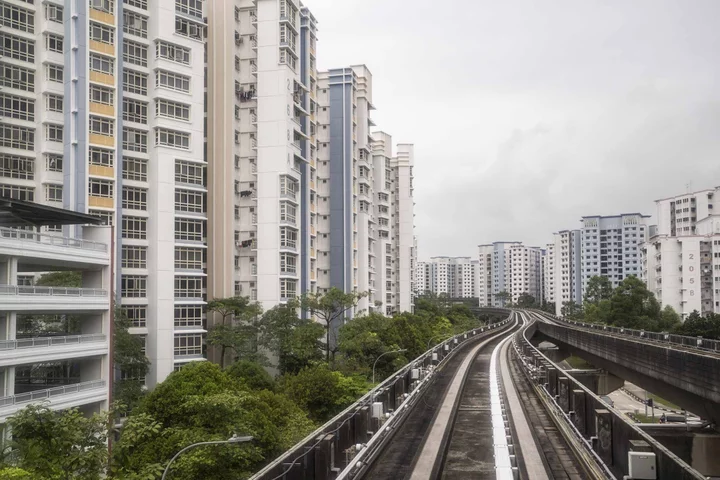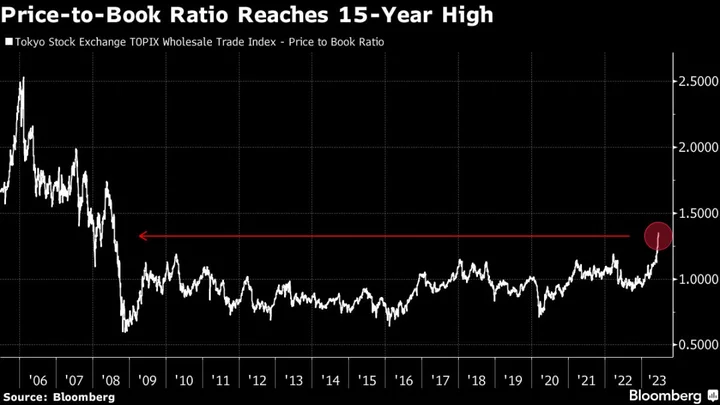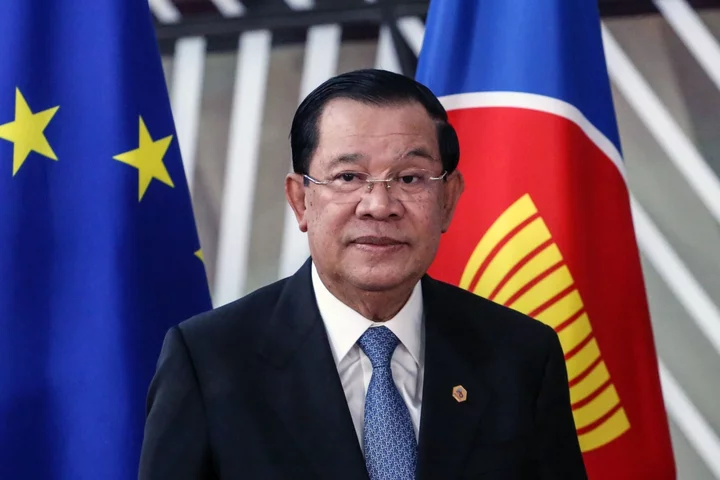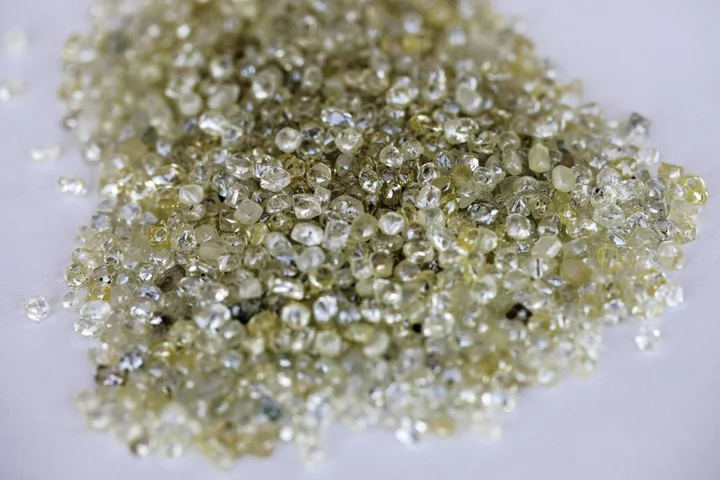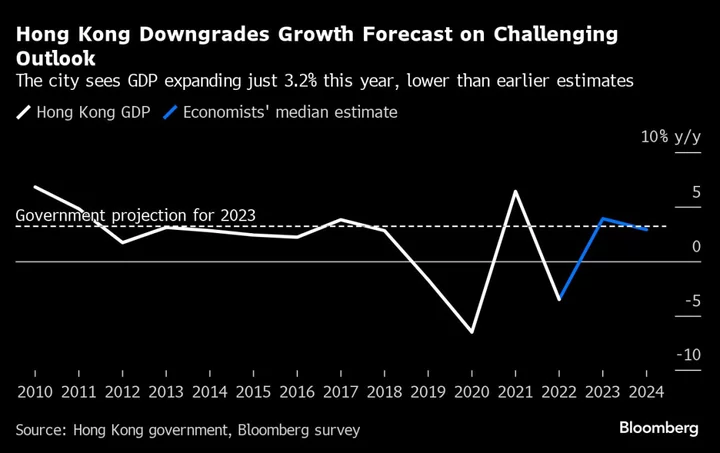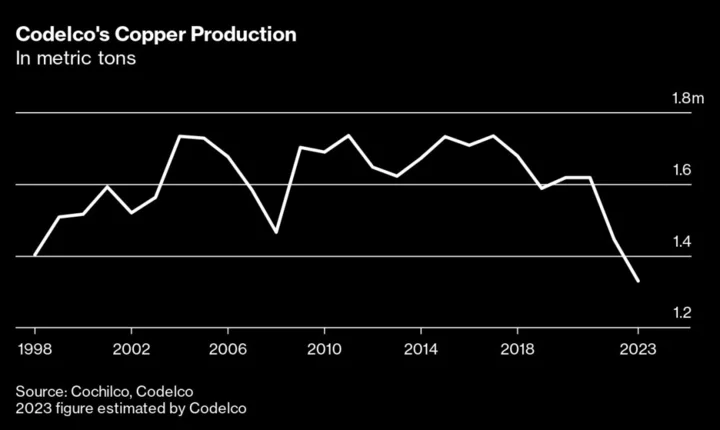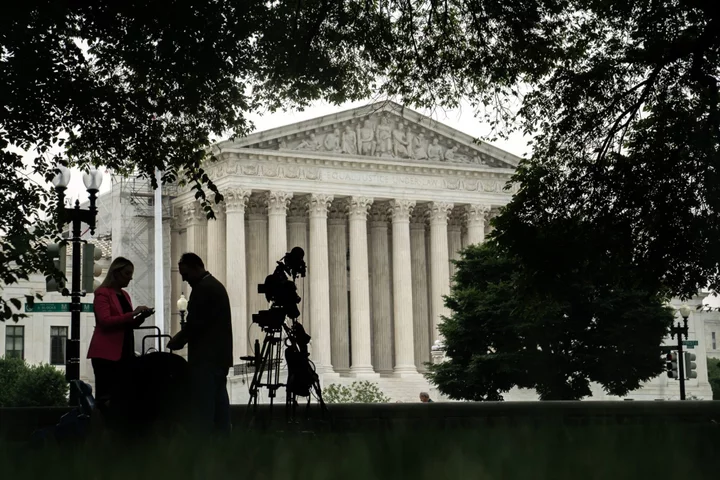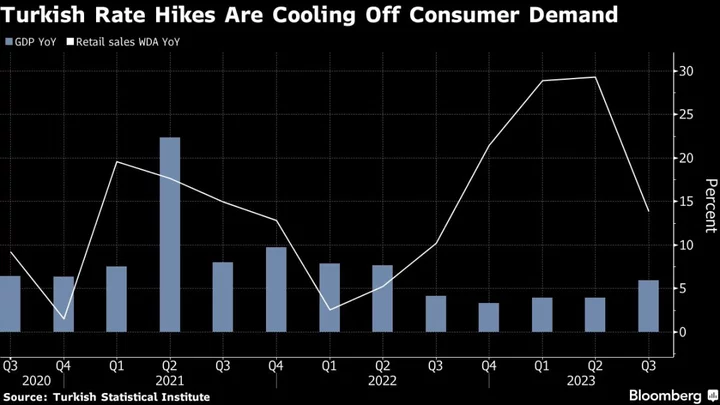(Bloomberg Markets) -- Rarely has a piece of antique office machinery been so venerated. The 1970s Hewlett-Packard calculator occupies a special place in Singapore storytelling. One of the first to roll off HP’s production line in the city-state, the number cruncher sits inside a glass case at the National Museum. The display is intended to showcase the republic’s openness to and prowess in attracting investment. It’s also an homage to the role state muscle played in attracting the likes of HP and assuring the company that Singapore was a place it could call home.
This is no ordinary exhibition. It’s part of a series of events to mark the centenary of the birth of Lee Kuan Yew, the founding prime minister of Singapore, a man lionized for his role in crafting a prosperous society and laying out the welcome mat for business. The retrospective encourages Singaporeans to see their country as an entrepôt, with some justification. The port is one of the world’s busiest, Changi Airport is consistently ranked highly, and the government is spending tens of billions of dollars to upgrade them both. The commercial activity coursing across the island has helped make its gross domestic product per capita among the highest in the world: more than $80,000, a level inconceivable when Singapore split with Malaysia in 1965.
Lee and his successors embraced free trade as a route out of poverty. They also wielded government brawn in the name of economic and social development. Right-wing American think tanks and fans of Brexit—who dreamed of a “ Singapore-upon-Thames” as a kind of free port of Europe—have held the country up as the epitome of a hands-off approach. Income taxes are low, though levies on consumption are rising. Infrastructure is top notch, businesses can be set up easily, and contracts are readily enforced. Strikes are almost unheard of. Government corruption is so rare that it makes a splash whenever a senior official is probed, as is currently happening to one cabinet minister in a case that’s grabbed headlines even though few specifics have been spelled out. The city-state ranks high on surveys measuring ease of business. According to one measure, Singapore overtook Hong Kong last year as Asia’s top financial center.
But this is just part of the story. Officialdom is never far away. Curbs on the sales of chewing gum and bans on jaywalking have long been staples of tourism folklore, but they tend to trivialize the pervasive role of government. State-backed companies play a big role in commercial life; the government-owned investment company Temasek Holdings is the largest shareholder in key publicly traded companies such as Singapore Telecommunications, DBS Group Holdings and Singapore Airlines. Most people live in public-built housing. Contributions to the Central Provident Fund, the national pension and savings plan, are mandatory for citizens and permanent residents; not only does it help fund retirement, but deposits on Housing & Development Board (HDB) flats can be paid by drawing on one’s account. The leading grocery-store chain was founded by the central labor union group, a partner of the ruling People’s Action Party. The main preschool operator boasts its status as “a PAP community foundation.” An identity card with fingerprints and a raft of biometric data are required for basics, such as visiting a clinic, opening a bank account and buying a phone, or the superfluous, such as getting a foot massage.
The policies that steer existence from cradle to grave are, of course, for Singaporeans to choose. There’s nothing inherently wrong with energetic administration. A functioning, competent state is among the foundations of successful society. It’s vital to meeting some of the century’s critical tests, like public-health emergencies, the demands of an aging society and climate change.
As essential—especially for those outsiders who deem the country as a model for their own—is recognizing that modern Singapore, for all its strengths and attractiveness as a place to live, didn’t just happen. Little has been left to chance, as John Curtis Perry, a professor at Tufts University, wrote in his 2017 book, Singapore: Unlikely Power: “Carefully planned and skillfully executed, under the firm guiding hand of Lee Kuan Yew, a centralized highly bureaucratic state concentrating on economic development began to take clear form. Government served as the avant garde of change, acting on behalf of the people, perceiving their wants as a comfortable life with political stability sustained by a rational pragmatic rule. The people, voicing their favorite pursuits as eating and shopping, fell into line nicely, voting overwhelmingly and continually for the PAP.”
Stamford Raffles typifies the shading in economic life. Raffles is remembered for establishing a free port on behalf of Britain in the early 1800s. Yet he was no dyed-in-the-wool free trader. He worked for the East India Co., a behemoth that championed monopolies, conquered territories, levied taxes—and then required a bailout by the Bank of England. Today the Raffles name adorns elite schools, medical clinics and a subway station downtown. There’s the Raffles Hotel, even a brand of beer. As Singapore endeavors to straddle escalating US-China commercial and diplomatic tensions, the imagery of Raffles may be even more valuable and his statue downtown sacrosanct. He tells people that the past, and authority, is far from banished, merely updated to reflect contemporary needs.
This change doesn’t have to produce sinister results or dire outcomes. The way in which government is enmeshed in Singapore life is illustrated by the handling of the coronavirus. Singapore’s low number of deaths and hospitalizations and limited school closures meant the country was considered a model. What wasn’t sufficiently appreciated beyond Singapore’s shores was how sui generis were the conditions for such success. The country has a single chamber of Parliament and no pesky federal system to complicate decision-making—and provide a forum for pushback. A contact-tracing app was required for entry into everything including the workplace and public bathrooms. Failure to comply with masking and limits on social gatherings risked fines, prison sentences and, in some circumstances, expulsion. Showing the undulating lanes of state enterprises, furloughed staff from Singapore Airlines joined the ranks of “safe-distancing ambassadors,” clad in red, quick with their cameras to report in cafes and on nature trails folks not complying. They were sometimes a benign, even helpful presence; other times, intimidating and bordering on the punitive.
Did Singapore go overboard, keep restrictions too tight for too long? Many foreign businesses were beginning to wonder. The 2020 recession was the worst the country had experienced. Officials prevailed upon bosses to protect the “Singapore core” at their workplace. Employers insufficiently attentive to advancing the careers of locals were on a watchlist, one minister told Parliament. Who was on that list? Hard to know, other than that Temasek-linked companies weren’t included. There was real fear of straying from not only the government’s directives but also its perceived preferences, and, problematically, gray areas. Stuff such as this doesn’t have to be the end of the world. Future pandemics will surely come, and Singapore has a template ready to go, warts and all.
The biggest challenge Asian societies face is demographics. Although Japan has long been the poster child of an aging and graying society, that country’s birthrate looks hearty compared with its neighborhood. Singapore’s total fertility rate, the average number of children a woman can expect to bear, retreated to 1.04 last year; 2.1 is considered the rate at which a population naturally replenishes itself. Singapore is on its way to becoming a “super-aged society,” according to the government, which estimates that by 2030, almost a quarter of Singaporeans will be 65 and above. There’s a natural role for policymakers to arbitrate and cater for this shift. In his National Day Rally, Prime Minister Lee Hsien Loong, the eldest son of the founding prime minister, outlined plans to top up state pensions and refit HDB townships for coming changes.
This demographic challenge, like many, is framed in terms of “collective will.” If all segments of society, not least the state, come together, then the Singapore story has room to run. “Nobody expected us to survive, much less to flourish,” the premier said in his speech. “But each time, we beat the odds. Each time, we showed the world what Singapore can be.”
This focus on the group, and the emphasis on cohesion, has become a significant part of Singapore’s fabric. The drawback is that it discourages risk-taking and fosters an embrace of the conservative. Speaking at a recent conference, Larry Summers, the former US secretary of the treasury, questioned whether, for all the attention Singapore showers on the knowledge economy, creativity is accorded the value it deserves. “I wonder how a person with the mixture of traits that Elon Musk has, or that Steve Jobs had, would function and would or would not be permitted to flourish in the Singporean system,” Summers said. “The optimal amount of rule-breaking in a creative society is substantially greater than zero.”
It prompts the question, with just months left in the LKY centennial year, whether another truly mold-breaking leader could climb to the top today. It hung over the conference, as it has over many gatherings dedicated to celebrating the city-state’s achievements and canvassing ways to prolong them.
The agency at the core of the campaign to lure HP and its descendants is the Economic Development Board, which almost functions as a hotel concierge, albeit with a stick. In an interview for the book Neither Civil Nor Servant by Peh Shing Huei, former EDB chief Philip Yeo recounts bullying the principal of the Singapore American School to find a place for the child of the man Western Digital Corp. appointed to run its local operation. SAS is a private institution, older than the Republic of Singapore itself. No matter, the industrial czar called. Fall into line.
Yeo didn’t quibble with terms like “social engineering”—provided it delivered for Singapore. It was jobs that mattered, he told Peh. In effect, survival. “I’m not your theoretical kind of guy. I don’t really care about the structure of the Singapore economy, because to me the structure is provided by the companies. What we provided were land, educated people, utilities, water. … What I wanted was to provide a home for them, a place for them to operate.”
Whatever Singapore looks like in its second half-century, the state will have a mighty role in getting there. The hand isn’t invisible, and that’s the way Singaporeans like it.
Moss is a Singapore-based columnist for Bloomberg Opinion. This column doesn’t necessarily reflect the opinion of Bloomberg LP and its owners.

